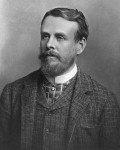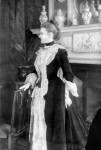This section presents a brief overview of the lives and families of Theodore and Mabel Bent. Our sister website, tambent.com, contains a wealth of information on the couple and their travels, plus lots of related material.
James Theodore Bent came into the world on March 30th 1852 at Bedford Street in Liverpool and spent his early years at the family home of Baildon House, near Bradford in Yorkshire in the north of England. He was the only child of James and Margaret Eleanor Bent. The family was wealthy, having made their money largely from the brewing and pottery industries, and young James had a very comfortable upbringing.
After preparatory school, he attended the prestigious Repton boarding school in Derbyshire and later Wadham College, Oxford from where he graduated with a B.A. degree in Modern History in 1875. On leaving university, Theodore, as he preferred to be called, took up law as a student at Lincoln’s Inn in London’s legal district. However, the world of law seemed too tame for Theodore and he never went on to become a barrister. His real interests lay in travel, social history and archaeology. Theodore is described in Gerald Brisch’s book as being ‘fair-haired, blue-eyed, short and stocky’.
Mabel Virginia Anna Hall-Dare was born at Beauparc House, County Meath in Ireland on January 28th 1846. The daughter of Robert Westley Hall-Dare and Frances Catherine Anna Lambart, she was descended from a line of Anglo-Irish aristocracy with strong, historic ties to the county of Essex, just outside London. Mabel must have inherited her mettle from her forebears. Her great-great-grandfather was Lord Mayor of London in 1743 and her great-grandfather was a planter in Guyana. Mabel’s father had relocated to Ireland from Essex sometime before Mabel’s birth and had established the family seat at Newtownbarry House in County Meath. The house is still owned by Mabel’s great-great-niece Clody Elizabeth Norton (née Hall-Dare). Although Mabel never lived in the existing house, which was only completed in 1889, she would have been familiar with the estate and the gardens of the house. Beauparc House was the home of Mabel’s grandfather and is now a private residence of a distant family member, dubbed the rock and roll aristocrat, following the death of the last direct descendant in 1986.
Gerald Brisch describes Mabel as being ‘Five feet eight inches tall, a green-eyed, sturdy redhead – striking in her photographs – her flaming, plaited hair was often the subject of native wonder. Outgoing and confident, she was as happy taking fences at full gallop in her native Wexford as she was dining with British ambassadors in Cairo or Constantinople.’
Theodore and Mabel married on August 2nd 1877. Both of independent financial means, they soon embarked upon their travels and each winter they would leave their home in London for extended tours abroad.
Their first trips were to Italy and in 1879 Theodore published a book on the republic of San Marino entitled A Freak of Freedom: Or, the Republic of San Marino. In recognition of his work, Theodore and Mabel were made honorary citizens of San Marino. In 1880 he published Genoa: How the Republic Rose and Fell, followed in 1882 by The Life of Giuseppe Garibaldi.
Their journeys around the Cyclades followed between 1883 and 1885 and the very successful book The Cyclades or Life Among the Insular Greeks was published in 1885. In the succeeding years they continued exploring the more easterly islands of the Aegean Sea, many of which were then Turkish, as well as the Aegean coast of Turkey.
1889 saw them exploring the Bahrain islands of the Persian Gulf. Their trip in 1891 to Africa was the basis for Theodore’s next best-seller, The Ruined Cities of Mashonaland, published in 1892. Ethiopia followed with the resulting book, The Sacred City of the Ethiopians, being published in 1893. During their final years of travel, Theodore and Mabel concentrated on the southern Arabian Peninsula and the African coast of the Red Sea.
It was on the island of Socotra, in the Gulf of Aden, that Theodore contracted the malaria that was to bring about his premature death. They managed to get back home to London but Theodore died four days later on May 5th 1897 at the age of just 45. Mabel buried her hero near her ancestral home at St. Mary the Virgin Church, in Theydon Bois, Essex.
Mabel never recovered from the loss of her constant partner, her travel companion and her raison d’être. She made a few more journeys abroad after Theodore’s death but found it ‘lonely’ and ‘useless’! With great strength she completed the book that Theodore had started, recounting their final journey; Southern Arabia was published in 1900. In 1904 she published A Patience Pocket Book and in 1908 Anglo-Saxons from Palestine: or, the Imperial mystery of the lost tribes.
The preface, and the final words, of Southern Arabia paint a poignant picture of Mabel’s deep grief and sadness:
If my fellow-traveller had lived, he intended to have put together in book form such information as we had gathered about Southern Arabia. Now, as he died four days after our return from our last journey there, I have had to undertake the task myself. It has been very sad to me, but I have been helped by knowing that, however imperfect this book may be, what is written here will surely be a help to those who, by following in our footsteps, will be able to get beyond them, and to whom I so heartily wish success and a Happy Home-coming, the best wish a traveller may have.
The book’s final two sentences read:
This is all I can write about this journey. It would have been better told, but that I only am left to tell it.
Mabel died at the age of 83 on July 3rd 1929 and was buried alongside Theodore at Theydon Bois. She and Theodore never had children and she never remarried. She spent the last 32 years of her life alone, perhaps living up to the motto on her family coat-of-arms – ‘Loyauté sans tache’ – ‘Unsullied loyalty’.
While their journeys throughout the Cyclades were full of adventure, and oft-times real danger, one finds it hard to imagine the courage and resolve needed to undertake those later journeys in such uncertain times to such dangerous places. Theodore and Mabel were, truly, intrepid explorers who contributed greatly to the knowledge we have today of the societies they researched on their travels.
You can read more about Theodore and Mabel’s extraordinary lives in Gerald Brisch’s excellent, meticulously-researched books:
- The Cyclades, or Life Among the Insular Greeks
- World Enough, and Time: The Travel Chronicles of Mrs J Theodore Bent Volume I: Greece and the Levantine Littoral
- Make Our Sun Stand Still: The Travel Chronicles of Mrs J. Theodore Bent. Volume II: The African Journeys
- Deserts of Vast Eternity: The Travel Chronicles of Mrs J. Theodore Bent: III: Southern Arabia and Persia
- The Dodecanese: Further Travels Among the Insular Greeks: Selected Writings of J. Theodore & Mabel V.A. Bent, 1885-1888
The following links provide additional biographical information:
- The website tambent.com is the authoritative source of information about the lives and travels of Theodore and Mabel and contains a wealth of related material. tambent.com is edited by Gerald Brisch, the author of several excellent books about the couple, and Alan King, the editor of this site.
- A contemporary biography of Theodore published in 1901
- The Wikipedia entry for Theodore
The following blogs on this site discuss different aspects of Theodore’s and Mabel’s lives:


